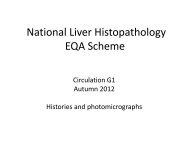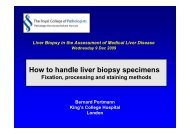Serrated Lesions
Serrated lesions - Virtual Pathology at the University of Leeds
Serrated lesions - Virtual Pathology at the University of Leeds
You also want an ePaper? Increase the reach of your titles
YUMPU automatically turns print PDFs into web optimized ePapers that Google loves.
<strong>Serrated</strong> <strong>Lesions</strong><br />
Geraint Williams<br />
Pathology Department<br />
Cardiff University
<strong>Serrated</strong> <strong>Lesions</strong><br />
Hyperplastic polyp<br />
<strong>Serrated</strong> adenoma<br />
Mixed polyp<br />
Sessile serrated polyp<br />
<strong>Serrated</strong> carcinoma
Hyperplastic Polyps<br />
• Formerly metaplastic polyps<br />
• Left > right, Male > female<br />
• Infolded epithelial tufts, microvesicular cells,<br />
infrequent enlarged goblet cells in upper crypts<br />
• May be prominent endocrine cells<br />
• May be thickened subepithelial collagen plate<br />
• No dysplasia<br />
• Failure of anoikis (shedding of mature cells)
Ki-67
Hyperplastic Polyp<br />
• Increase in frequency with age<br />
• 17 times commoner in colons with carcinoma<br />
• Similar dietary and lifestyle risk factors to CRC<br />
• K-ras mutation common<br />
• Clonal<br />
• Monocryptal?
<strong>Serrated</strong> Adenoma<br />
Dysplasia by definition, usually low grade<br />
Eosinophilic cytoplasm<br />
Pseudostratified, ‘pencillate’ nuclei<br />
May be tubular, tubulovillous or villous<br />
Invade to give serrated carcinoma<br />
Longacre & Fenoglio-Preiser 1990
Traditional <strong>Serrated</strong> Adenoma<br />
1-15% of all adenomas<br />
Often left sided<br />
Frequently pedunculated, villiform<br />
Short, budding, ‘ectopic’ crypts<br />
‘Filiform’ variants<br />
Torlakovic et al 2003, 2008<br />
Yantiss et al 2007
‘Traditional’ <strong>Serrated</strong> adenoma (TSA)
Filiform <strong>Serrated</strong> Adenoma
Mixed Polyps<br />
Collision between hyperplastic polyp and<br />
adenoma<br />
Dysplasia in Hyperplastic Polyp<br />
Longacre & Fenoglio-Preiser 1990
Sessile <strong>Serrated</strong> Lesion<br />
(Polyp, Adenoma)<br />
• <strong>Serrated</strong> polyps with unusual architectural features<br />
o<br />
o<br />
Horizontal orientation of deep crypts<br />
Serration down to crypt base<br />
• No conventional dysplasia but may have ‘nuclear<br />
atypia’ or ‘hypermucinous’ change<br />
• Right colon<br />
• Females > males<br />
• Large sessile, poorly defined<br />
Torlakovic & Snover 1996
Sessile <strong>Serrated</strong> Lesion<br />
(Polyp, Adenoma)<br />
• Crypt dilatation<br />
• Abnormal proliferation<br />
• Normal subepithelial collagen plate<br />
• Loss of MLH1<br />
• Sometimes found in hyperplastic polyposis<br />
• Often express MUC5AC or MUC6<br />
Torlakovic et al 2003 AJSP 27: 65-81
Sessile serrated lesion
<strong>Serrated</strong> Adenocarcinoma<br />
• 5-10% colorectal cancer<br />
• Right colon and rectum<br />
• <strong>Serrated</strong>, mucinous or trabecular growth<br />
pattern<br />
• Abundant eosinophilic cytoplasm<br />
• Chromatin condensation<br />
• Preserved polarity<br />
• No ‘dirty’ necrosis
<strong>Serrated</strong> Adenocarcinoma
Garcia-Solano J et al 2010 Hum Pathol 41: 1359-68
<strong>Serrated</strong> Adenocarcinoma<br />
• Most arise in traditional serrated<br />
adenomas and are MSS<br />
– Distal tumours<br />
– Poor prognosis (30% 5-year survival)<br />
• 20% arise in sessile serrated polyps and<br />
have MSI<br />
– Proximal tumours<br />
– Good prognosis (70% 5-year survival)<br />
Makinen et al 2001 J Pathol 193: 286-94
MLH1
Right Sided <strong>Serrated</strong><br />
Neoplasia<br />
Microsatellite instability<br />
MLH1 inactivation<br />
DNA methylation (CIMP)<br />
BRAF mutation (80% in SSAs)<br />
Baker K et al J Clin Pathol 2004; 57: 1089
BRAF mutation<br />
• Typical adenomas 0%<br />
• Typical hyperplastic polyps 19%<br />
• Sessile serrated adenomas 75-82%<br />
• Traditional serrated adenomas 20-30%<br />
• Mixed Polyps 57-89%<br />
• HNPCC cancers 0%<br />
• All colorectal cancers 15%<br />
• MSI-high non-HNPCC cancers 76%
<strong>Serrated</strong> Neoplasia Pathway<br />
Proximal hyperplastic polyp<br />
Sessile serrated polyp<br />
Sessile serrated adenoma<br />
MSI-high, methylation-rich<br />
non-HNPCC “serrated” carcinoma<br />
Higuchi T & Jass JR 2004 J Clin Pathol 57: 682
Left Sided <strong>Serrated</strong> Neoplasia<br />
Microsatellite stable<br />
MLH1 expression retained<br />
DNA methylation (CIMP)<br />
No BRAF mutation<br />
K-ras mutation (80% in TSAs)
Traditional <strong>Serrated</strong><br />
Neoplasia Pathway<br />
Hyperplastic polyp<br />
(Goblet cell type)<br />
Traditional serrated adenoma<br />
Distal MSS non-HNPCC serrated<br />
carcinoma<br />
Higuchi T & Jass JR 2004 J Clin Pathol 57: 682
From: Noffsinger AE Ann Rev Pathol Mech Dis 2009; 4: 343-64
1250 Polyps at Colonoscopy<br />
Polyp Dysplasia %<br />
Adenoma Tubular + 55<br />
Tubulovillous + 15<br />
Villous + 1<br />
<strong>Serrated</strong> Hyperplastic - 24.5<br />
polyps Sessile <strong>Serrated</strong> Polyp - 2.5<br />
Mixed Polyp + 0.8<br />
<strong>Serrated</strong> Adenoma (TSA) + 1.2<br />
Frequency of SSPs reaches 7% in some series;<br />
observer reproducibility is an issue!
Risk of Malignancy in Sessile<br />
<strong>Serrated</strong> <strong>Lesions</strong><br />
– Unknown<br />
– Up to 20% of cancers arise by the serrated<br />
pathways<br />
– Microsatellite instability may speed up the<br />
evolution into carcinoma<br />
– Patients with SSAs more likely to have additional<br />
serrated lesions and proximal hyperplastic polyps<br />
– Case reports of rapid evolution of SSA to cancer<br />
– Small series suggest further neoplasia occurs with<br />
similar (or greater) frequencies in SSA patients<br />
compared with adenoma patients
Natural History of Sessile<br />
<strong>Serrated</strong> Adenomas<br />
– Asymptomatic population, 50-75 yrs, undergoing<br />
screening colonoscopy, N=3121<br />
– 7.9% had Proximal large (>10mm) Non-dysplastic<br />
<strong>Serrated</strong> Polyps<br />
– More likely than those without proximal NDSP to<br />
have advanced neoplasia (17.3% vs 10.0%) at<br />
baseline<br />
– Large proximal NDSP and no neoplasia at baseline<br />
3.14 times more likely to have subsequent<br />
neoplasia<br />
Schreiner MA et al Gastroenterology 2010; 139: 1497-1502
Natural History of Sessile<br />
<strong>Serrated</strong> Adenomas<br />
– 40 patients with SSAs and no history of colonic<br />
neoplasia<br />
– 5 (12.5%) developed cancer, all in proximal colon<br />
– 4/5 cancers had MSI<br />
– 1.8% matched adenoma patients developed cancer<br />
Lu FI et al AJSP 2010; 34: 927-34
Sessile <strong>Serrated</strong> Adenomas and<br />
‘Advanced’ Histology<br />
– Lieberman D et al<br />
Polyp Size and Advanced Histology in Patients<br />
Undergoing Colonoscopy Screening: Implications<br />
for CT Colonography<br />
Gastroenterology 2008; 135: 1100-5<br />
– Van Dekken et al<br />
Screening for colorectal cancer: randomised trial<br />
comparing guaiac-based and immunochemical<br />
faecal occult blood testing and flexible<br />
sigmoidoscopy. Gut 2010; 59: 62-8
Management of Patients with<br />
<strong>Serrated</strong> <strong>Lesions</strong><br />
Typical Small Distal Hyperplastic Polyps<br />
No follow-up<br />
Right sided <strong>Serrated</strong> <strong>Lesions</strong><br />
Caution – depends on age, comorbidity, family<br />
history etc (but some recommend 3 yearly<br />
surveillance)<br />
Sessile serrated polyps >1cm<br />
Excise and follow up for recurrence ~3 yearly<br />
Dysplastic serrated lesions<br />
As adenomas
Reporting <strong>Serrated</strong> <strong>Lesions</strong><br />
Current requirements and proformas do not<br />
record serrated lesions per se (apart from<br />
hyperplastic polyps).<br />
<strong>Serrated</strong> adenomas are recorded with<br />
conventional tubular, tubulovillous or villous<br />
adenomas – serration is not recognised.<br />
SSPs are reported as right sided hyperplastic<br />
polyps – this may be harming people!
Reporting <strong>Serrated</strong> <strong>Lesions</strong><br />
Time for Change:<br />
We need to agree a nomenclature for right sided<br />
sessile non dysplastic lesions – SSP or SSA<br />
(or SSA/P)<br />
We must introduce categories for serrated adenomas<br />
and sessile serrated polyps in proformas, and modify<br />
diagnostic guidelines accordingly<br />
We must review regularly the management implications<br />
for patients with serrated lesions.
• <strong>Serrated</strong> <strong>Lesions</strong>, once the Cinderellas of Colorectal<br />
Pathology, are assuming increased interest and clinical<br />
importance<br />
• They probably contribute to the pathogenesis of up to<br />
20% of Colorectal Cancers<br />
• <strong>Serrated</strong> adenomas are biologically different in the<br />
left and right colons<br />
• There is, as yet, insufficient data on which to make<br />
firm recommendations on surveillance of individuals<br />
with sessile serrated polyps without overt dysplasia<br />
• We must modify our recording/reporting of serrated<br />
lesions within the BCSP
Acknowledgements<br />
The late Jeremy Jass<br />
Marco Novelli

















